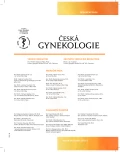Embolic event in the puerperium with tragic end
Authors:
M. Poláček
Authors‘ workplace:
Gynekologicko-porodnické oddělení, Masarykova nemocnice, Rakovník, primář MUDr. R. Poláček
Published in:
Ceska Gynekol 2019; 84(2): 145-148
Category:
Case Report
Overview
Objective: To present a case of a patient with embolic event in the puerperium at the surgery for residual trophoblastic tissue.
Design: Case report.
Setting: Department of Obstertics and Gynaecology, Hospital Rakovník.
Case report: We present the 33-year-old second-graders case of three weeks of labor at 40th weeks, which was operated at our workplace for residual trophoblastic tissue. The gynecological surgery took place without complications, however, after the operation, breathing and circulation arrest. Thrombolysis was given for suspicion of embolization etiology. In spite of an intense urgent CPR and multidisciplinary collaboration, there is a failure in the life and death of the patient.
Conclusion: In presenting this serious case of an embolic event, the author want to emphasize the need for proper diagnosis, an indication of the surgical performance or the conservative procedure for placental remnants in the puerperium.
Keywords:
embolic event – maternal death
Sources
1. American College of Chest Physicians. Antithrombotic therapy and prevention of thrombosis. 9th ed. American College of Chest Physicians Evidence-Based Clinical Practice Guidelines. Chest, 2012, 141 (2 suppl.), p. e419S–e7236S.
2. Binder, T, Salaj, P., Vavřinková, B. Hematologické nemoci a poruchy v porodnictví a gynekologii. 1. vyd. Praha: Triton, 2004, s. 160–167.
3. Hrazdírová, L., Kužel, D., Žižka, Z. Je hysteroskopie správná volba pro řešení reziduí těhotenských tkání ? Čes Gynek, 2012, 77, 1, s. 35–38.
4. Kuzel, D., Horak, P., Hrazdirova L., et al. „See and treat“ hysteroscopy after missed abortion. Minim Invasive Ther Allied Technol, 2011, 20, 1, p. 14–17.
5. Kuzel, D., Horak, P., Hrazdirova L., et al. „See and treat“ hysteroscopy: limits of intrauterine pathology bulk. Ces Gynek, 2006, 71, 4, p. 325–328.
6. Kužel, D., Tóth, D., Mára, M. Základy panoramatické hysteroskopie. 1. vyd. Praha: Grada, 2016, s. 22–24.
7. Marshall, AL. Diagnosis, treatment and prevention of venous tromoembolism in pregnancy. Postgrad Med, 2014, 126, p. 25–34.
8. Maslovitz, S., Almog, B., Mimouni, GS., et al. Accuracy of diagnosis of retained products of conception after dilation and evacuation. J Ultrasound Med, 2004, 23, 6, p. 749–756, quiz 758–749.
9. Pařízek, A., et al. Kritické stavy v porodnictví. 1. vyd. Praha: Galén, 2012, s. 105–107.
10. Sultan, AA., Tata, LJ., West, J., et al. Risk factors for first venous thromboembolism around pregnancy: a population-based kohort study from the United Kingdom. Blood, 2013, 121, p. 3953–3961.
11. Ustunyurt, E., Kaymak, O., Iskender, C., et al. Role of transvaginal sonography in the diagnosis of retained products of conception. Arch Gynecol Obset, 2008, 277, 2, p. 151–154.
12. Weeks, AD. The retained placenta. Best Pract Res Clin Obset Gynaecol, 2008, 22, 6, p. 1103–1117.
Labels
Paediatric gynaecology Gynaecology and obstetrics Reproduction medicineArticle was published in
Czech Gynaecology

2019 Issue 2
Most read in this issue
- Uterine rupture during pregnancy and delivery: risk factors, symptoms and maternal and neonatal outcomes – restrospective cohort
- Sacrococcygeal teratoma
- Operative vaginal deliveries and their impact on maternal and neonatal outcomes – prospective analysis
- Latest findings on the placenta from the point of view of immunology, tolerance and mesenchymal stem cells
